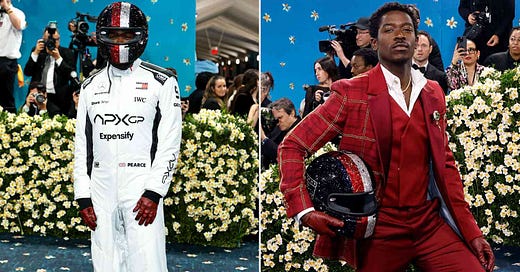The Genius Behind Tommy Hilfiger’s F1-Fueled Met Gala Moment
The fashion brand embraced its motorsport heritage, embedding itself authentically in pop culture and executing a moment that was both emotionally resonant and visually iconic at the recent event
Haven't subscribed yet? Join our community of sports enthusiasts eager to broaden their understanding of global sports. Whether you're a student, professional, or business owner, our newsletter provides invaluable insights into the sports industry.
Damson Idris rolled into the 2025 Met Gala not on foot, but in full throttle. The British actor dressed head-to-toe in a dazzling APXGP racing suit, complete with a helmet bedazzled with 20,000 Swarovski crystals, brought cinematic spectacle to the carpet. As flashbulbs snapped, the suit was ripped away to reveal a tailored Tommy Hilfiger tuxedo underneath – flawlessly capturing both the Met Gala theme and the pulse of a global cinematic event. It was a fashion-meets-film moment that became instantly viral.
Most red carpet stunts fade fast. But this one had layers. Tommy Hilfiger didn't just make a splash; they built a narrative. By turning Idris’s outfit change into a metaphorical gear shift – from the high speed of F1 to the high style of tailoring – they reminded the world that Hilfiger isn’t just a clothing label, but a brand deeply embedded in cultural storytelling.
Tommy Hilfiger’s long-standing relationship with motorsport isn’t just convenient, it’s foundational. With roots tracing back to partnerships with Team Lotus, Ferrari, and most notably Lewis Hamilton, Hilfiger has spent decades weaving itself into the fabric of F1 and recently with the Academy. Its presence in the F1 movie isn’t a one-off, instead, it’s a continuation of a story the brand’s been telling since the 1990s, now reimagined for a younger, style-conscious, sport-savvy audience.
Many brands slap their names on event backdrops or kits and call it a day. Not Hilfiger. Their execution during the Met Gala, which mirrored scenes from the upcoming F1 movie, created a seamless brand activation that lived both on and off-screen. It wasn’t about visibility, it was about experience. The message was clear: Tommy Hilfiger lives at the intersection of speed, sophistication, and spectacle.
Here’s the genius: Tommy Hilfiger is both a real-world F1 sponsor and the official fashion partner of the fictional APXGP team in the movie. This dual presence grants them a rare credibility in both realms. They can use the IP, create activations, and speak authentically to fans of the sport and the movie which is something most other sponsors simply can’t do.
Expensify, GEICO, and SharkNinja have scored big visibility by sponsoring the fictional APXGP team. Yet, without deeper rights or activations beyond the movie, their campaigns risk being surface-level. Sponsorship without a strategy for emotional engagement or storytelling often results in fleeting impact, especially with a fandom as passionate and discerning as F1’s.
Access to logos and branding is just the entry ticket. The real value lies in using those rights to build immersive, multi-channel campaigns that create a lasting experience for the audience. Tommy Hilfiger can put the APXGP team on a hoodie, a pop-up store experience, or a behind-the-scenes YouTube/web series. Others? They’ll struggle unless they negotiate deeper partnerships or pivot to find other authentic entry points into the F1 ecosystem.
With the F1 film poised to reach audiences far beyond typical race-day viewers, Hilfiger is brilliantly positioned, even for launching exclusive products. Casual fans who will come for Brad Pitt may leave with an appreciation for F1 and perhaps a Hilfiger jacket from the shopping mall. Meanwhile, lifelong F1 enthusiasts see a brand that has championed their sport for decades, now making it cool for the mainstream.
Nonetheless, Idris’s entrance went viral not just because it was unexpected but because it was the product of a brand that knew its history, its future, and its moment. From sponsoring real F1 legends to supporting a fictional F1 narrative, the legendary fashion brand timed this to perfection, ensuring it rode the waves of both the Met Gala and motorsport buzz simultaneously.
In an age where attention is currency, Tommy Hilfiger proved that when sponsorship fuses entertainment, legacy, and cultural relevance, the result is unforgettable. It’s no longer enough to sponsor; brands must activate, connect, and belong. For Hilfiger, the Met Gala was a checkered flag moment, which is proof that they’re not just keeping up with culture, they’re setting the pace.
Some housekeeping stuff
If you can’t find the newsletter, check your Spam folder or Promotions tab, and move this email to your primary inbox. Make sure to mark this email address as ‘not spam’.
Today’s recommended podcast…
In this episode of Business of Sport, Nicolas Julia, founder of Sorare, shares how Sorare moved beyond traditional fantasy sports to create a new digital frontier. Where player cards are assets, fans become managers, and NFT technology meets real-world gameplay.
The conversation dives deep into Sorare’s strategic edge, its ability to bring global athlete investors like Serena Williams and Kylian Mbappé on board, not just for credibility, but to shape the platform itself. The challenges of working with legacy sports organisations and how education plays a big role in building trust.
It’s a global perspective on the sports market, from the contrasting dynamics of US vs European fan engagement to the ways Sorare identifies its next big opportunities. With insights on athlete IP, betting markets, and the business of fandom, this episode is a playbook for the future of sports, tech, and ownership.






